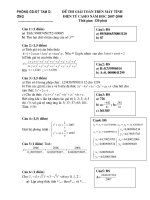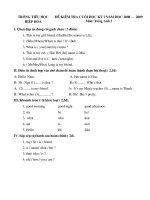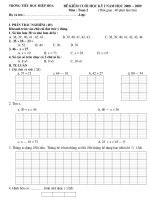- Trang chủ >>
- Đề thi >>
- THPT Quốc Gia
Đề 2019 HAY
Bạn đang xem bản rút gọn của tài liệu. Xem và tải ngay bản đầy đủ của tài liệu tại đây (73.49 KB, 6 trang )
Chỉ 300.000 nhận trọn bộ các tài liệu dưới đây
- 166 đề thi thử THPTQG 2019 môn Anh file word giải chi tiết
- 213 đề thi thử THPTQG 2018 môn Anh file word giải chi tiết
- Tự Ôn Luyện THPTQG- Tác giả: Dương Hương Vui lòng liên hệ ĐT hoặc
Zalo: O937.351.1O7
Đề dự bị Sở 07
Mark the letter A, B, C or D to indicate the word whose underlined part differs from the other
three in pronunciation in each of the following questions.
Question 1: A. repeats
B. amuses
C. attacks
D. coughs
Question 2: A. capable
B. ancient
C. angle
D. danger
Mark the letter A, B, C or D to indicate the word that differs from the other three in the position of
the primary stress in each of the following questions.
Question 3: A. recommend
B. fortunately
C. entertain
D. disappear
Question 4: A. curriculum
B. peninsula
C. professional
D. auditorium
Mark the letter A, B, C or D to indicate the underlined part that needs correction in each of the
following questions.
Question 5: She was anxious about the interview because she failed three interviews before.
A
B
C
D
Question 6: Not until much later did she realize that her long-known partner had been lying her.
A
B
C
D
Question 7: It is noisy enough in this room, so I would rather you stop shouting like that.
A
B
C
D
Mark the letter A, B, C or D to indicate the correct answer to each of the following questions.
Question 8: That Marie was able to retire at the age of 50 __________.
A. so successful her business was
B. so successful was her business
C. her business was successful
D. so was her successful business
Question 9: The suspect confessed __________.
A. the police his crime
B. at his crime
C. his crime the police
D. his crime to the police
Question 10: His advice, I would never have got the job ___________.
A. except
B. but for
C. apart from
D. as for
Question 11: More than a mile of roadway has been blocked with trees, stones and other debris, _____ the
explosion.
A. causing
B. caused by
C. which caused by
D. which caused
Question 12: I __________ the bell three times when he answered the door.
A. would ring
B. rang
C. had rung
D. was ringing
Question 13: I'm thinking of changing my job because there are few _____ of promotion.
A. prospects
B. opportunities
C. chances
D.sources
Question 14: Bill has a real ______ for looking after handicapped children.
A. career
B.post
C. inspiration
D.vocation
1
Question 15: The death of Tran Lap, the leader of a Vietnamese famous rock band called Buc Tuong,
is a great ________ to his fans.
A. losing
B. loss
C. lose
D. lost
Question 16: I ________ an old friend of mine in the street this morning. We haven't seen Each other
for ages.
A. ran into
B. ran out
C. came over
D. came round
Question 17: Tom is _____ with his teacher because he didn't do any assignments.
A. in danger
B. in the dark
C. in hot water
D. under control
Question 18: These facts may be familiar _______ you.
A. to
B. with
C. in
D. at
Question 19: The government is building a nuclear power ________ not far from here.
A. works
B. factory
C. station
D. industry
Mark the letter A, B, C or D to indicate the most suitable response to complete each of the
following exchanges.
Question 20: Mai and Lan are friends. Lan asks Mai about Mai's plan. Select the most suitable response
to fill in the blank.
Lan: “Are you going to see the live show by Son Tung today?”
Mai: “__________”.
A. Yes, I enjoyed it very much
B. Maybe I'll be out
C. Yes, I'm going to stay in
D. I think so
Question 21: Andy: How about coming to my English class tonight?
Bob: ______________________.
A. Sounds like fun! What time?
B. English is my favourite subject.
C. Don't worry. Thanks.
D. Thanks. But what's the problem?
Mark the letter A, B, C or D to indicate the word/phrases SIMILAR in meaning to the underlined
word(s) in each of the following questions.
Question 22: The news should be put in the most noticeable place so that all the students can be well
informed.
A. suspicious
B.popular
C. easilyseen
D. beautiful
Question 23: I told her I understood what she was feeling as we were both after all in the same
boat.
A. in a similar take
B. in a similar find
C. in a similar situation
D. in a similar case
Mark the letter A, B, C or D to indicate the word or phrase that is OPPOSITE in meaning to the
underlined part in each of the following questions.
Question 24: He was arrested for his illicit drug trade in the police raid yesterday.
A. legal
B. irregular
C. elicited
D. secret
Question 25: I eat lunch with a convivial group of my friends.
A. unsociable
B. large
C. old
D. lively
Mark the letter A, B, C or D to indicate the sentence that is closest in meaning to each of the
following questions.
2
Question 26: If their car hadn't broken down, these people would have come to the meeting in time.
A. These people didn't come to the meeting because their car broke down.
B. These people came to the meeting late because their car broke down.
C. These people were late for the meeting because they didn't pick them up.
D. If they had picked up these people, they wouldn't have been late for the meeting.
Question 27: My friend had no difficulty in passing the driving test.
A. My friend found it easy to pass the driving test.
B. My friend found it impossible to pass the driving test.
C. My friend succeeded in passing the driving test.
D. Passing the driving test shouldn't be too taxing for my friend.
Question 28: “I'm very sorry for what happened but you will just have to accept the truth.” Laura said
to her friend.
A. Laura took the responsibility for what had happened.
B. Laura didn't mean to tell the truth.
C. Laura apologized to her friend for what had happened.
D. Laura consoled her friend.
Mark the letter A, B, C or D to indicate the sentence that best combines each pair of sentences in the
following questions.
Question 29: I whispered. I didn't want anybody else to hear our conversation.
A. I whispered so nobody could hear our conversation.
B. I whispered so that somebody could not hear our conversation.
C. I whispered so that nobody could not hear our conversation.
D. I whispered so that nobody could hear our conversation.
Question 30: The girl is talking to a man with a ponytail. She is my friend.
A. The girl who is talking to a man with a ponytail is my friend.
B. The girl, whom a man with a ponytail is talking to, is my friend.
C. My friend is the girl, who is talking to a man with a ponytail.
D. The girl, who is talking to a man with a ponytail, is my friend.
Read the following passage and mark the letter A, B, C or D to indicate the correct word or phrase
that best fits each of the numbered blanks from 31 to 35.
GETTING TO THE ROOT OF BONSAI CRIME
Bonsai trees have always been a source of great fascination to people. They are perfect miniatures,
grown in pots small enough to sit on a windowsill. You have to keep reminding yourself that these
frees are actually real and identical to their larger cousins in all (31) ______except their size. Rather
like other small and perfectly-formed artifacts, bonsai trees command quite a high price in the
marketplace and so it doesn't come as a great surprise to find that they also (32) ______the attention
of thieves. It seems that quite a flourishing business has evolved, in which they are stolen from the
homes of growers and collectors, then repotted and trimmed by unscrupulous dealers, to be sold on, at
good prices, to (33) ______buyers.
One of Britain's top collectors of bonsai trees, Paul Widdington, believes that he has found a
solution, however. After losing his life's work, valued at £250,000, when burglars broke into his home one
night, Paul decided to (34) ______the possibilities of electronically tagging the trees he bought as
a replacement. This involves injecting a microchip the size of a grain of rice into the trunk of each tree.
Each chip is a laser-etched with information which is stored in a central register held by the police. Paul is
3
quite aware that this kind of data-tagging doesn't (35) ______thieves from stealing the trees in the
first place, although it may increase the chances of getting them back. So he's also installing a security
alarm system complete with infra-red detectors, in his home.
Question 31: A. concerns
B. respects
C. regards
D. matters
Question 32: A. attract
B. inquire
C. appeal
D. invite
Question 33: A. unavoidable
B. undemanding
C. unconscious
D. unsuspecting
Question 34: A. look into
B. set about
C. try out
D. go after
Question 35: A. preserve
B. prevent
C. prohibit
D. protect
Read the following passage and mark the letter A. B, C or D to indicate the correct answer to
each of the questions from 36 to 42.
In ancient Greece, athletic festivals were very important and had strong religious associations. The
Olympic athletic festival, held every four years in honour of Zeus, eventually lost its local character,
became first a national event, and then, after the rules against foreign competitors had been abolished,
international. No one knows exactly how far back the Olympic Games go, but some official records
date from 776 B.C.
The Games took place in August on the plain by Mount Olympus. Many thousands of spectators
gathered from all parts of Greece, but no married woman was admitted even as a spectator. Slaves, women
and dishonoured people were not allowed to compete. Records show that the evening of the third day
was devoted to sacrificial offerings to the heroes of the day, and the fourth day, that of the full moon,
was set aside as a holy day. On the sixth and last day all the victors were crowned with holy garlands of
wild olive from a sacred wood. So great was the honour that the winner of the foot race gave his name to
the year of his victory. How their results compared with modern standards, we unfortunately had no
means of telling.
After an uninterrupted history of almost 1,200 years, the Games were abolished in A. D. 394
because of their pagan origin. It was a great many years before there was another such international athletic
gathering. The Greek institution was brought back into existence in 1896 and the first small meeting took
place in Athens. After the 1908 London Olympics, success was re-established and nations sent their best
representatives.
Today, the Games are held in different countries in turn. The host country provides vast facilities,
including a stadium, swimming pools and living accommodation, but competing countries pay their
own athletes' expenses. Athletic contests are still the main feature, but now many more sports are
represented, women compete, the ancient pentathlon, for example, has been modified into a more
comprehensive test, and the marathonraces, initiated in 1896, are now a celebrated event.
The Olympics start with the arrival in the stadium of a torch, lighted on Mount Olympus by the
sun's rays. It is carried by a succession of runners to the stadium. The torch symbolizes the continuation
of the ancient Greek athletic ideals, and it burns throughout the Games until the closing ceremony.
Question 36: The first Olympic Games took place________.
A. in the 17th century A.D
B. certainly before 700 B.0
C. over three thousand years
D. a thousand years ago
Question 37: At the ancient Olympic Games, any competitor had to be _________.
A. Greek
B. male
C. unmarried
D. neither a slave nor a foreign
Question 38: During the Games, on the evening before the moon was full, ________.
A. sheep and cattle were sacrificed to Zeus
4
B. all the victors were crowned with garlands
C. olive branches were gathered from a sacred wood
D. the heroes were honoured with sacrificed offerings
Question 39: The word "pagan" (3rd paragraph) is closest in meaning to _________.
A. Greek
B. Olympic
C. religious
D. sporty
Question 40: The continuity of the Olympic Games _______.
A. was broken in the year A.D 1200
B. was broken in 1896
C. was interrupted for over 1,500 years
D. was interrupted for almost 1,200 years
Question 41: The word "continuation" (the last paragraph) is closest in meaning to ______.
A. keep going
B. a progress
C. process
D. marching
Question 42: The modern Olympics compared with the ancient ones are ________.
A. inspired by the same ideas
B. more restricted in the variety of events
C. different in every respect
D. too much concerned with international rivalry
Read the following passage and mark the letter A, B, C or D to indicate the correct answer to
each of the questions from 43 to 50.
The technology of the North American colonies did not differ strikingly from that of Europe,
but in one respect, the colonists enjoyed a great advantage. Especially by comparison with Britain,
Americans had a wonderfully plentiful supply of wood.
The first colonists did not, as many people imagine, find an entire continent covered by a climax
forest. Even along the Atlantic seaboard, the forest was broken at many points. Nevertheless, all sorts of fine
trees abounded, and through the early colonial period, those who pushed westward encountered new forests.
By the end of the colonial era, the price of wood had risen slightly in eastern cities, but wood was still
extremely abundant.
The availability of wood brought advantages that have seldom been appreciated. Wood was a
foundation of the economy. Houses and all manner of buildings were made of wood to a degree
unknown in Britain. Secondly, wood was used as fuel for heating and cooking. Thirdly, it was used as the
source of important industrial compounds, such as potash, an industrial alkali; charcoal, a component of
gunpowder; and tannic acid, used for tanning leather.
The supply of wood conferred advantages but had some negative aspects as well. Iron at that time
was produced by heating iron ore with charcoal. Because Britain was so stripped of trees, she was unable
to exploit her rich iron mines. But the American colonies had both iron ore and wood; iron production was
encouraged and became successful. However, when Britain developed coke smelting, the Colonies did not
follow suit because they had plenty of wood and besides, charcoal iron was stronger than coke iron. Coke
smelting led to technologic innovations and was linked to the emergence of the Industrial Revolution. In
the early nineteenth century, the former colonies lagged behind Britain in industrial development because
their supply of wood led them to cling to charcoal iron.
Question 43: What does the passage mainly discuss?
A. The advantages of using wood in the colonies.
B. The effects of an abundance of wood on the colonies.
C. The roots of the Industrial Revolution.
5
D. The difference between charcoal iron and coke iron.
Question 44: The word strikingly in the first paragraph is closest in meaning to _______.
A. realistically
B. dramatically
C. completely
D. immediately
Question 45: Which of the following is a common assumption about the forests of North America
during the colonial period?
A. They contained only a few types of trees.
B. They existed only along the Atlantic seaboard.
C. They had little or no economic value.
D. They covered the entire continent.
Question 46: The word "abundant" in paragraph 3 is closest meaning to _________-.
A. redundant
B. sufficient
C. insufficient
D. plentiful
Question 47: According to the passage, by the end of the colonial period, the price of wood in Eastern
cities ________.
A. rose quickly because wood was becoming so scarce.
B. was much higher than it was in Britain.
C. was slightly higher than in previous years.
D. decreased rapidly because of lower demand for wood.
Question 48:What can be inferred about houses in Britain during the period written about in the
passage?
A. They were more expensive than American houses.
B. They were generally built with imported materials.
C. They were typically smaller than homes in North America.
D. They were usually built from materials other than wood.
Question 49: Which of the following is NOT mentioned as a source of industrial compounds?
A. potash
B. charcoal
C. gunpowder
D. tannic acid
Question 50: According to the passage, why was the use of coke smelting advantageous?
A. It led to advances in technology.
B. It was less expensive than wood smelting.
C. It produced a stronger type of iron than wood smelting.
D. It stimulated the demand for wood.
Vui lòng mua trọn bộ Đề 2019 với giá 300k
để xem đáp án và lời giải. Liên hệ ĐT và Zalo O937.351.107
288
6









